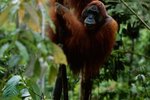
Along with chimpanzees, orangutans and humans, gorillas are members of the family Hominidae. Each of the modern species traces their evolution to a common ancestor that lived about 10 million years ago. Over those 10 million years, the four lineages have developed adaptations that have allowed them to thrive in different ways. Gorillas have evolved a distinct diet, social organization and method of locomotion to help the species to survive.
Gorilla Classification and Diversity
Scientists recognize two species of gorilla -- eastern gorillas (Gorilla beringei) and western gorillas (G. gorilla) -- each with two subspecies. The eastern lowland and mountain gorilla live in the central portions of equatorial Africa, while the western lowland and Cross River gorilla inhabit western Africa. Each subspecies exhibits morphological differences; many of which have obvious adaptive advantages, such as the longer hair, larger size and shortened forearms of mountain gorillas, which help them to survive in the cooler climate.
Diet
Unlike their two closest relatives -- humans and chimpanzees, who consume plant and animal food -- gorillas are largely herbivorous. Large gorillas may consume up to 60 pounds of leaves, grasses, shoots and bark in a day. Most of their feeding activity happens in the morning and again in the evening. Though they acquire most of their food at ground level, gorillas can climb -- western gorillas climb up to 50 feet high to access food. Gorillas rotate their use of plants within their range, which allows the forest to regenerate as they move, alleviating the need for vast territories.
Social Structure
Like most of their relatives, gorillas are social animals. Differing from the Bonobo chimpanzees (Pan paniscus) -- which exhibit female-dominated societies -- gorilla troops are led by the largest male. This dominant male often develops white or silver hairs on his back as he ages, earning him the name “silverback.” This male will lead the group as they feed, sleep and socialize, as well as defend the group from threats or predators. Males exhibit a stereotyped threat display to predators or intruders, which may involve screaming, roaring, beating their chests, throwing things or destroying vegetation.
Locomotion
Because of their significant bulk -- large gorillas may exceed 400 pounds at 6 feet in height -- gorillas primarily travel quadrepedally, in a behavior termed “knuckle walking.” Though awkward looking, gorillas can attain 20 miles per hour when necessary, over short distances. Gorillas can stand on their rear legs for short periods of time, but they generally walk with the aid of their front limbs. Gorillas climb well, but because of their large size, they must remain near the tree’s trunk.
References
- Animal Diversity Web: Gorilla Beringei
- Animal Diversity Web: Gorilla Gorilla
- National Geographic: Mountain Gorilla
- National Geographic: Lowland Gorilla
- The Journal of Experimental Biology: Differential Scaling of Locomotor Performance in Small and Large Terrestrial Mammals
- National Geographic: Gorillas More Related to People Than Thought, Genome Says
- Developments in Primatology: Progress and Prospects: Patriarchal Chimpanzees, Matriarchal Bonobos: Potential Ecological Causes of a Pan Dichotomy
Resources
Photo Credits
-
Tom Brakefield/Stockbyte/Getty Images




